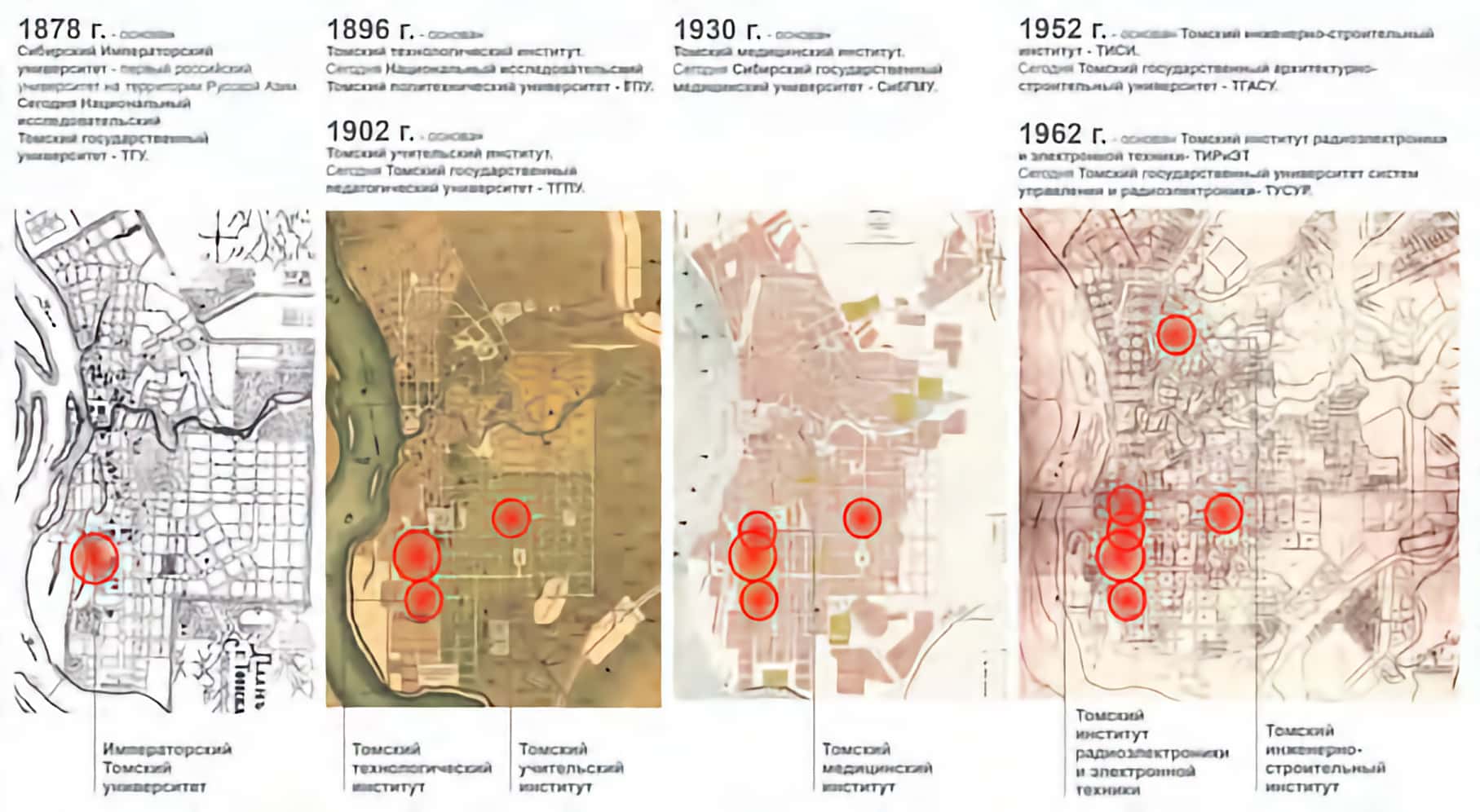Tomsk case analysis
Downloads
DOI:
https://doi.org/10.51461/issn.2309-3072/83.2509Keywords:
university city, scientific and technical potential, urban studies, urban development, innovations, human capital, sustainable developmentAbstract
Nowadays, such factors of urban development and territorial competitiveness as investments in human capital and scientific research and development, i.e. knowledge embodied in intellectual potential and innovations, come to the fore. Based on this premise, the mission of the driving force and supporting territories of the development is assigned to university cities, where the scientific and educational complex performs a system-forming function. At the post-industrial stage of civilization development, factory cities are replaced by university cities and science cities. The key hypothesis of the article is that the scientific and technical potential of a city correlates with the degree of manifestation of the features and attributes of a university city.
How to Cite
Published
Issue
Section
References
Abashkin, V., Abdrakhmanova, G., Bredikhin, S. et al. (2023). Russian Regional Innovation Scoreboard. Issue 8 (L. Gokhberg, Ed.). National Research University Higher School of Economics. Moscow: HSE University. Retrieved February 13, 2025, from https://issek.hse.ru/mirror/pubs/share/879447941.pdf
Best Student Cities 2022. (n.d.). Top Universities. Retrieved January 20, 2025, from https://www.topuniversities.com/city-rankings/2022?tab=indicators&countries=Russia
Duranton, G., & Puga, D. (2001). Nursery Cities: Urban Diversity, Process Innovation, and the Life Cycle of Products. American Economic Review, 91(5), 1454–1477.
Fuller, S. (2008). Sotsialnaya epistemologiya universiteta: kak sohranit tselostnost znaniya v tak nazyvaemom obschestve znaniya [Social Epistemology of University: How to Keep the Generalnyi plan MO
“Gorod Tomsk” [Master plan of the city of Tomsk]. (n.d.). Tomsk City Administration. Retrieved February 14, 2025, from https://admin.tomsk.ru/pgs/2ro
Hudyakov, V. V., & Merzlov, I. Yu. (2020). Scientific and Technical Potential: Analysis of Theoretical and Methodological Approaches. Tomsk State University Journal of Economics, 52, 75–87. DOI:10.17223/19988648/52/5
Kak zarabotat pervyi million: retsept ot bizness-inkubatora TUSURa [How to make your first million: a recipe from TUSUR business incubator]. (2024). Platform of university technological entrepreneurship of the Ministry of Science and Higher Education of the RF. Retrieved February 13, 2025, from https://univertechpred.ru/novosti/20240321-kakzarabotat-pervyy-million-retsept-ot-biznes-inkubatora-tusura/#
Knowledge Continuity in so Called Knowledge Society]. Epistemology & philosophy of science, 15(1), 158–186.
Kuleshova, G. I. (2021). The University and the City. Essays on Evolution of Connection between University Institution and Urban Environment. Part 1: World Practice. Academia. Architecture and Construction, 4, 70–79.
Maksimova, K. A., & Korenev, V. I. (2022). City-planning aspects of university campus locations in Tomsk. Vestnik Tomskogo gosudarstvennogo arhitekturno-stroitelnogo universiteta, 24(1), 137–149. DOI 10.31675/1607-1859-2022-24-1-137-149. EDN IGVKDO.
Marshall, A. (1919). Industry and Trade. London: Macmillan.
Natsionalnyi reiting nauchno-tekhnologicheskogo razvitiya subyektov RF [National rating of scientific and technological development of the constituent entities of the Russian Federation]. (n.d.). Ministry of Science and Higher Education of the RF. Retrieved February 13, 2025, from https://www.minobrnauki.gov.ru/Методология. Национальный%20рейтинг%20НТР.pdf
Opredeleny devyat regionov, v kotorykh sozdadut kampusy mirovogo urovnya [Nine regions identified to create world-class campuses]. (2022).
Ministry of Science and Higher Education of the RF. Retrieved February 13, 2025, from https://minobrnauki.gov.ru/press-center/news/novostiministerstva/61962/
Pasport goroda Tomska [Passport of the city of Tomsk]. (n.d.). Tomsk City Administration. Retrieved February 15, 2025, from https://admin.tomsk.ru/pgs/0m
Postanovlenie Pravitelstva RF ot 21.12.2005 № 783 “O sozdanii na territorii g. Tomska osoboi ekonomicheskoi zony tekhnikovnedrencheskogotipa” [Resolution of the Government of the Russian Federation No. 783 of 21.12.2005 “On the Establishment of a Special Economic Zone of Technology Innovative Type in the Territory of Tomsk”]. (2005). Garant. Retrieved February 13, 2025, from https://base.garant.ru/12143829/
Presidential Decree № 400 of 2 July 2021. (2021). Strategiya natsionalnoi bezopasnosti RF [National Security Strategy of the Russian Federation]. Retrieved January 20, 2025, from http://static.kremlin.ru/media/events/files/ru/QZw6hSk5z9gWq0plD1ZzmR5cER0g5tZC.pdf
Recommendation concerning the International Standardization of Statistics on Science and Technology: UNESCO. (n.d.). Retrieved February 14, 2025, from https://uis.unesco.org/sites/default/files/documents/recommendation-concerning-the-international-standardization-ofstatistics-on-science-and-technology-historical-en_0.pdf
Reiting innovatsionnogo razvitiya subyektov Rossiiskoi Federatsii [Rating of innovative development of the constituent entities of the Russian Federation]. (n.d.). HSE. Retrieved February 15, 2025, from https://www.hse.ru/primarydata/rir
Romer, P. M. (1994). The Origins of Endogenous Growth. Journal of Economic Perspectives, 8(1), 3–22.
Rozhdestvensky, R. (1964). V Tomske – ekzameny [Exams in Tomsk]. Smena, 22, 22.
Senge, P. (2018). The Fifth Discipline: The Art and Practice of the Learning Organization. Moscow: Mann, Ivanov i Ferber.
Shatilo, D. P. (2021). University Cities in Europe: Concept, Development Specifics and Urban Planning Patterns. Outlines of Global Transformations: Politics, Economics, Law, 14(4), 23–39. DOI:10.23932/2542-0240-2021-14-4-2
Tomsk stal studencheskoi stolitsei Rossii [Tomsk has become the student capital of Russia]. (2015, December 22). Rossiyskaya Gazeta.
Turgel, I. D., Bugrov, K. D., & Oyher, A. D. (2023). Russian University Cities: Expectations vs. Reality. Higher Education in Russia, 32(5), 89–111. DOI: 10.31992/0869-3617-2023-32-5-89-111
UNESCO Global Network of Learning Cites: Guiding Docements. (2025).
UNESDOC. Retrieved February 4, 2025, from https://unesdoc.unesco.org/ark:/48223/pf0000234986_rus
Verhoef, L., & Bossert, M. (2019). The University Campus as a Living Lab for Sustainability. A Practitioner’s Guide and Handbook. TU Delft.
Yigitcanlar, T. (2011). Position paper: Redefining knowledge-based urban development. International Journal of Knowledge-Based Development, 2(4), 340–356.
Za 46 mesyatsev: Chto izvestno o proekte mezhvuzovskogo kampusa v Tomske [In 46 months: What is known about the interuniversity campus project in Tomsk]. (2023, September 25). RIATOMSK. February 13, 2025, from https://www.riatomsk.ru/article/20230925/kampus-tomskkoncessiya-podrobnosti/




